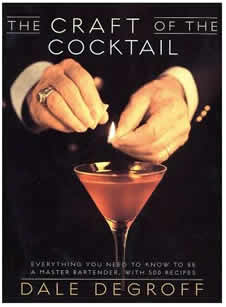 The Craft of the Cocktail
The Craft of the Cocktail
Dale Degroff
240 pages
Clarkson Potter Publishers
The sport of downing as much alcohol in as short a time as possible has its time and place, I don’t deny anyone that. But I’ve always thought of alcohol as something special, something to be enjoyed, savored and appreciated. I would never order a gourmet dinner at a fine restaurant and then gobble it as fast as I could. Why bother? Why not just grab a hamburger? This is the underlying theme of Dale Degroff’s new book, The Craft of the Cocktail.
Degroff takes a few pages in the beginning to talk about the cocktail’s history. His writing style is surprisingly light and personal, making you feel like he’s there sharing a drink with you: “There’s something about the Bloody Mary that makes people competitive. Every weekend bartender in America has his own, and of course, his is the best recipe in Western Civilization. But this is really the best recipe” (86). Scattered throughout the book are stories of his career behind the bar, the people he met, and drinks he invented. These fragments tell a story all their own of one man’s influence on — and debt to — a sopping wet society.
The next section focuses on each individual spirit’s history and traditional uses, and lists common brands from value to premium to super premium. He goes into detail as to what differentiates spirits from one region to another and how they’re related. Concerning Vodka he says, “Along with the texture, the Absolut-style vodkas have a hint of sweetness in the aftertaste that is missing in the Stolichnaya. Scandinavian countries tend to produce vodka in the silky style with the hint of sweet in the finish. Russian countries produce vodkas with the clean, almost dry medicinal finish” (20). All interesting material that any good drunkard should know.
There are 500 recipes, enough to keep you busy for a year, and then some. Degroff has done extensive research for original cocktail recipes from the 1800’s, unearthed long out of print manuals and books, resurrected many cocktails, tweaking them for modern ingredients, tastes and proportions. Stories and comments complement many of the recipes, making it a crime to merely skim over them. He gives credit to other mixologists where due, and a drink’s history when he can. Popular drinks like the Martini and Bloody Mary receive special attention. These drinks take on a new flavor when one is no longer merely drinking alcohol, but history itself.
Degroff approaches the creation of a cocktail like the creation of a fine dish. His attention to detail and insistence on fresh ingredients are completely focused on making the best tasting cocktail possible. It is clearly an art like any other, but Degroff makes you feel like the creation of a Monet is at your fingertips.
There is one thing above all which makes me recommend this book. I received it at Christmas and left it on the coffee table for the holidays. Every single person who visited immediately picked it up, flipped through it, and proudly exclaimed, “Here it is!” when they found their favorite drink. They eagerly told all of their stories of drinks gone by, which of course made us all thirsty. Many trips to the liquor cabinet were called for. Even my grandfather, who I’ve never seen drink a drop, told us how he went home during lunch period in elementary school to take a couple shots before going back, “so I could sit still.” This book made for constant conversation, reminiscing and laughter, making this one of the most cheerful holidays we’ve had.
The Craft of the Cocktail is essential for any drunkard’s collection. It is a pleasure to read, cover to cover, packed with useful and unique information and tips, sophisticated yet completely accessible. Any guest who isn’t fascinated with this book should be politely escorted to the door. Cheers!
—John Hamm










